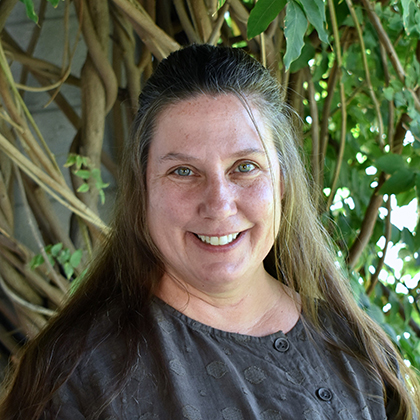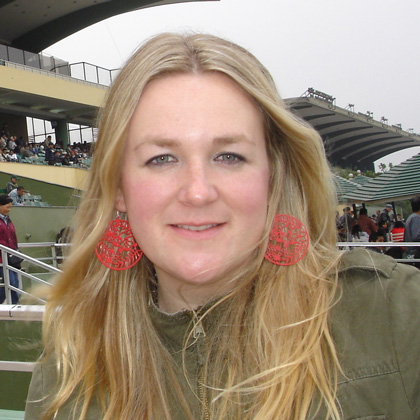EnVRonment: Immersive Environmental Studies using Virtual Reality Technology
Shellie Zias-Roe
 As an environmental scientist and certified professional urban and environmental planner, I have always been interested in the environment and education. By applying knowledge of the natural world and its processes, I develop projects and programs that protect the environment while promoting the health and well being of its inhabitants. A personal commitment to scholarly inquiry resulted in a doctoral degree from Prescott College in Sustainability Education where I engaged in transformative and experiential learning across multiple disciplines including biophilia, civic and human ecology, natural resource management, collaborative governance, sense of place, environmental & equity planning, and environmental impact assessment. Since 2006, my environmental practice has centered on environmental and community planning for a large county in Southern California as well as environmental consulting. My research and engagement efforts have focused on the earth and human connection and the study of resiliency within social-ecological systems. I am interested in the application of systems thinking to transform the lives of people and the environment through multi-perspectival connections. I have also earned bachelor’s degrees in Environmental Management and Liberal Arts from the University of Redlands, and a master of applied science degree in Environmental Policy and Management: Natural Resource Management from the University of Denver. Currently, I am a Visiting Assistant Professor at the University of Redlands in the Environmental Studies Department, teaching Environmental Planning, Environmental Impact Assessment, Sustainability Planning, and Professional Development in Environmental Careers.
As an environmental scientist and certified professional urban and environmental planner, I have always been interested in the environment and education. By applying knowledge of the natural world and its processes, I develop projects and programs that protect the environment while promoting the health and well being of its inhabitants. A personal commitment to scholarly inquiry resulted in a doctoral degree from Prescott College in Sustainability Education where I engaged in transformative and experiential learning across multiple disciplines including biophilia, civic and human ecology, natural resource management, collaborative governance, sense of place, environmental & equity planning, and environmental impact assessment. Since 2006, my environmental practice has centered on environmental and community planning for a large county in Southern California as well as environmental consulting. My research and engagement efforts have focused on the earth and human connection and the study of resiliency within social-ecological systems. I am interested in the application of systems thinking to transform the lives of people and the environment through multi-perspectival connections. I have also earned bachelor’s degrees in Environmental Management and Liberal Arts from the University of Redlands, and a master of applied science degree in Environmental Policy and Management: Natural Resource Management from the University of Denver. Currently, I am a Visiting Assistant Professor at the University of Redlands in the Environmental Studies Department, teaching Environmental Planning, Environmental Impact Assessment, Sustainability Planning, and Professional Development in Environmental Careers.
Hillary Jenkins
 Geology, paleoclimatology, dendroclimatology, isotope geochemistry, and hydrology. Current research interests include tree rings and extreme drought in Amazonia and the southwestern United States, spatio-temporal patterns of water distribution, quality, and scarcity in southern California, deforestation and carbon budget estimates over the Amazon rainforest using remote sensing geospatial analysis techniques, earthquakes and forest ecosystem growth and carbon loss, and the tectonics of the Altyn Tagh Fault on the North Tibetan Plateau.
Geology, paleoclimatology, dendroclimatology, isotope geochemistry, and hydrology. Current research interests include tree rings and extreme drought in Amazonia and the southwestern United States, spatio-temporal patterns of water distribution, quality, and scarcity in southern California, deforestation and carbon budget estimates over the Amazon rainforest using remote sensing geospatial analysis techniques, earthquakes and forest ecosystem growth and carbon loss, and the tectonics of the Altyn Tagh Fault on the North Tibetan Plateau.
Project Summary
Recent advances in the field of virtual reality technology provide a unique pedagogical opportunity to bring the field environment into the classroom. Traditional approaches to Environmental Science education have relied upon physical relocation of the class into the field through field trips, field based laboratories, and research experiences. However, these trips are time consuming, costly, and require a small student: faculty ratio. This proposal seeks to address these obstacles by integrating virtual field experiences into existing Environmental Studies courses. Special attention will be given to EVST courses that do not currently include a field-based component. Virtual field laboratories radically expand the possibilities for environmental science education through tangible, visual interface that creates “interactivity to engage students, abstraction of 2D and 3D geographic objects (e.g. soils, terrain) and dynamic ecosystem processes (e.g. water flow) using geostatistics and scientific visualization techniques” (Ramasundaram et al., 2005).
In addition to the obvious pedagogical benefits of VR in the environmental classroom, VR also expands the potential for international virtual experiences, research, and development, supporting and affirming international student inclusiveness.
In this project, I propose to use my Environmental Impact Assessment (EVST 235), Environmental Planning (EVST 360F), and Resilient Cities (EVST 360S) courses to examine the intersection of human influence, changes to the environment, and impacts within the context of community development. We will also discuss and visualize mitigation strategies implemented by communities to adapt to climate change. H. S. Jenkins will adapt aspects of her field-based courses (EVST 205, 391 and 392) to utilize VR – likely through pre-laboratories. By modifying our courses simultaneously, we will be able to examine the effectiveness of VR in both traditional field-based courses and non-field-based courses.
I intend to introduce 360° videos to students through environmental topics as they are introduced throughout the semester. For instance, transportation impacts and sustainable transportation could be addressed through the “Bike Unfriendly Mumbai” 360° video when discussing impacts to communities that lack non-motorized transportation infrastructure and best management practices. Specifically, we are interested in learning if students taking environmental courses that do not typically include a field experience are actively engaged while building upon their existing knowledge of the natural and built environment in an inclusive environment. And lastly, I am personally excited to utilize technology that incorporates universal design in higher education.
At the completion of these VR-pilot courses (EVST 235, EVST 360F, EVST 360S), I will evaluate the effectiveness of this approach via anecdotal surveys that assess overall attitudes about VR technology and ways to improve upon the technology and delivery of VR content in future courses.
Lastly, I hope to write an article of the experience for a peer reviewed journal or a summary of the courses integrating VR for the University of Redlands Our House publication. I will present my proposal and teaching experience during the Faculty Technology Projects Showcase.

 As an environmental scientist and certified professional urban and environmental planner, I have always been interested in the environment and education. By applying knowledge of the natural world and its processes, I develop projects and programs that protect the environment while promoting the health and well being of its inhabitants. A personal commitment to scholarly inquiry resulted in a doctoral degree from Prescott College in Sustainability Education where I engaged in transformative and experiential learning across multiple disciplines including biophilia, civic and human ecology, natural resource management, collaborative governance, sense of place, environmental & equity planning, and environmental impact assessment. Since 2006, my environmental practice has centered on environmental and community planning for a large county in Southern California as well as environmental consulting. My research and engagement efforts have focused on the earth and human connection and the study of resiliency within social-ecological systems. I am interested in the application of systems thinking to transform the lives of people and the environment through multi-perspectival connections. I have also earned bachelor’s degrees in Environmental Management and Liberal Arts from the University of Redlands, and a master of applied science degree in Environmental Policy and Management: Natural Resource Management from the University of Denver. Currently, I am a Visiting Assistant Professor at the University of Redlands in the Environmental Studies Department, teaching Environmental Planning, Environmental Impact Assessment, Sustainability Planning, and Professional Development in Environmental Careers.
As an environmental scientist and certified professional urban and environmental planner, I have always been interested in the environment and education. By applying knowledge of the natural world and its processes, I develop projects and programs that protect the environment while promoting the health and well being of its inhabitants. A personal commitment to scholarly inquiry resulted in a doctoral degree from Prescott College in Sustainability Education where I engaged in transformative and experiential learning across multiple disciplines including biophilia, civic and human ecology, natural resource management, collaborative governance, sense of place, environmental & equity planning, and environmental impact assessment. Since 2006, my environmental practice has centered on environmental and community planning for a large county in Southern California as well as environmental consulting. My research and engagement efforts have focused on the earth and human connection and the study of resiliency within social-ecological systems. I am interested in the application of systems thinking to transform the lives of people and the environment through multi-perspectival connections. I have also earned bachelor’s degrees in Environmental Management and Liberal Arts from the University of Redlands, and a master of applied science degree in Environmental Policy and Management: Natural Resource Management from the University of Denver. Currently, I am a Visiting Assistant Professor at the University of Redlands in the Environmental Studies Department, teaching Environmental Planning, Environmental Impact Assessment, Sustainability Planning, and Professional Development in Environmental Careers. Geology, paleoclimatology, dendroclimatology, isotope geochemistry, and hydrology. Current research interests include tree rings and extreme drought in Amazonia and the southwestern United States, spatio-temporal patterns of water distribution, quality, and scarcity in southern California, deforestation and carbon budget estimates over the Amazon rainforest using remote sensing geospatial analysis techniques, earthquakes and forest ecosystem growth and carbon loss, and the tectonics of the Altyn Tagh Fault on the North Tibetan Plateau.
Geology, paleoclimatology, dendroclimatology, isotope geochemistry, and hydrology. Current research interests include tree rings and extreme drought in Amazonia and the southwestern United States, spatio-temporal patterns of water distribution, quality, and scarcity in southern California, deforestation and carbon budget estimates over the Amazon rainforest using remote sensing geospatial analysis techniques, earthquakes and forest ecosystem growth and carbon loss, and the tectonics of the Altyn Tagh Fault on the North Tibetan Plateau.